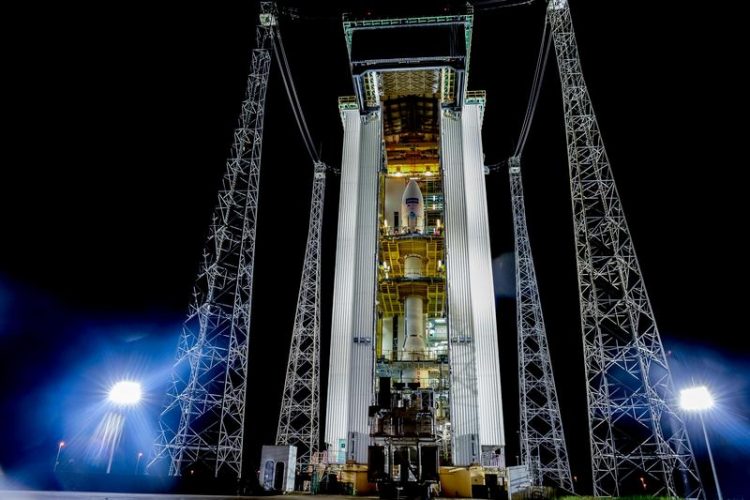Lasers for Fast Internet in Space – Space Technology from Aachen

Ready for lift-off: Vega launcher rocket. ESA-M. Pedoussaut, 2015
After eight years of preparation, in the early morning of June 23 the time had come: in Kourou in French Guiana, the European Space Agency launched the Sentinel-2A satellite aboard a VEGA launcher.
It is the first of two satellites which will be used to improve environmental monitoring under the European Copernicus program. To transfer the extensive image data, a new technology is being used: The data are sent to a relay satellite with a laser beam and sent from there to the ground station.
Both Sentinel-2 satellites will monitor the status of forests and farmland from space. It should also provide data on the pollution of lakes and coastal waters. Its images of floods, volcanic eruptions and landslides will be a great help to react quickly in case of disaster and to coordinate humanitarian assistance more efficiently.
In 2014 the European Space Agency ESA established a fast data connection between near-Earth satellites and those more remote. Cutting-edge laser technology enables a transfer rate of up to 1.8 Gbit/s over a maximum of 40,000 km, which is about 30 times faster than what has previously been possible. This monitoring system for environment and security, where time play a critical role, is seen as an application like the European Copernicus program.
The technology for the ground-breaking data link comes from Germany: the so-called Laser Communication Terminal (LCT) was developed by the Space Administration of the German Aerospace Center (DLR) with funds from the Federal Ministry of Economics and Technology (BMWi) and Tesat-Spacecom in charge. In collaboration with Tesat-Spacecom, Fraunhofer ILT planned, qualified and mounted the space-ready diode-laser pump module.
From conception to design, manufacture and testing, Fraunhofer ILT provides all the expertise for the development of laser and optical modules for use in the aerospace industry. This know-how is based on decades of experience in various missions and research projects.
Fraunhofer as a system provider for space components
The Fraunhofer ILT is member of the Fraunhofer Alliance for Space, a consortium of 15 institutions that operate in the field of applied research for space technology.
Contact
Dipl.-Ing., Dipl.-Wirtsch.-Ing. Martin Traub
Group Leader Optics Design and Diode Lasers
Telephone +49 241 8906-342
martin.traub@ilt.fraunhofer.de
Fraunhofer Institute for Laser Technology ILT
Steinbachstraße 15
52074 Aachen, Germany
Hans-Dieter Hoffmann
Leader of the competence area Lasers and Laser Optics
Telephone +49 241 8906-206
hansdieter.hoffmann@ilt.fraunhofer.de
Fraunhofer Institute for Laser Technology ILT
Steinbachstraße 15
52074 Aachen, Germany
Media Contact
All latest news from the category: Physics and Astronomy
This area deals with the fundamental laws and building blocks of nature and how they interact, the properties and the behavior of matter, and research into space and time and their structures.
innovations-report provides in-depth reports and articles on subjects such as astrophysics, laser technologies, nuclear, quantum, particle and solid-state physics, nanotechnologies, planetary research and findings (Mars, Venus) and developments related to the Hubble Telescope.
Newest articles

Bringing bio-inspired robots to life
Nebraska researcher Eric Markvicka gets NSF CAREER Award to pursue manufacture of novel materials for soft robotics and stretchable electronics. Engineers are increasingly eager to develop robots that mimic the…

Bella moths use poison to attract mates
Scientists are closer to finding out how. Pyrrolizidine alkaloids are as bitter and toxic as they are hard to pronounce. They’re produced by several different types of plants and are…

AI tool creates ‘synthetic’ images of cells
…for enhanced microscopy analysis. Observing individual cells through microscopes can reveal a range of important cell biological phenomena that frequently play a role in human diseases, but the process of…





















